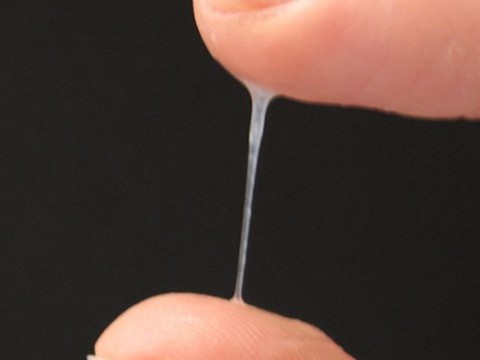Many women rely on charting their menstrual cycles and checking basal body temperature to as one of the tell-tale ovulation symptoms, but do you know how to monitor your cervical mucus? Cervical mucus changes in texture, color and consistency throughout a woman’s cycle. By understanding what these changes mean, you can determine if you are ovulating.
It may not be as surefire a method as a digital ovulation predictor to be 100% sure you’re experiencing ovulation symptoms, but changes in cervical mucus are quite recognizable if you know what to look for.

Ovulation Symptoms: Collecting cervical mucus
Some women may have enough cervical mucus to collect a sample on a piece of toilet paper when they wipe. If this is not the case for you, you can also place a clean finger inside the vagina, toward the cervix. By circling the finger around the cervix, you will be able to collect a sample of cervical mucus.
Ovulation Symptoms: Examining cervical mucus
Examine cervical mucus every day. Record the texture, color and consistency of the mucus on a chart to help monitor your cycle. Consistency of cervical mucus can be determined by stretching the mucus between two fingers, to see if it can be easily stretched or not. Some women may need to chart changes in cervical mucus for several months before they learn what is normal for their body.
Ovulation Symptoms: Types of cervical mucus
As your hormone levels fluctuate, the types of vaginal discharge you experience will change, this is why examining mucus daily during your cycle for predicting ovulation symptoms is critical. Here is what to look for during the different phases of your monthly cycle:
Menstrual Cycle:
Women will notice the typical menstrual bleeding and vaginal discharge that accompanies the menstrual cycle, and it is unlikely to become pregnant during this time.
Before Ovulation:
Immediately after the menstrual cycle ends, women are not ovulating yet. If a woman checks for the presence of cervical mucus, she will usually find that she has little to no discharge. Most women will feel dryness around the vulva and will not have any noticeable discharge during this time.
Approaching Ovulation:
Women will notice small amounts of a sticky discharge prior to ovulation. Cervical mucus may appear cloudy and have a white or creamy color. The discharge will be thin at first, and increase in volume as a woman’s cycle progresses. If a woman stretches the mucus between her fingers, it will easily break apart.
Ovulation:
A few days prior to ovulation, cervical mucus changes significantly. It will appear watery, slippery or have an egg white consistency. The amount will of cervical mucus will increase as well. If you try to pull the mucus apart during this phase, it could be stretched and would not easily break apart. The egg white consistency cervical mucus during ovulation may last for several days. During this time, women are the most fertile and have the best chance of conceiving.
After Ovulation:
Cervical mucus will change immediately after ovulation back to a sticky discharge that appears in smaller amounts. Before a woman beings her next menstrual cycle, she may have little to no discharge and feel dryness again.
When to consult a doctor about your ovulation symptoms